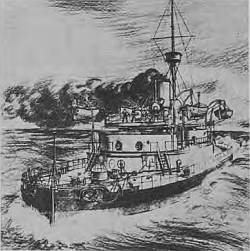- Author
- Webb, P
- Subjects
- None noted
- Tags
-
- RAN Ships
- None noted.
- Publication
- August 1972 edition of the Naval Historical Review (all rights reserved)

The last vessel built for the Colony of Victoria was the first class torpedo boat Countess of Hopetoun. She was built at the yard of Yarrow and Co. on Thames, and as the contract called for delivery at Williamstown, she was sailed out rigged as a threemasted schooner. The voyage lasted 154 days. Her displacement was 75 tons, and her dimensions 130 feet by 13 feet 6 inches beam. She had a 6-inch torpedo tube built into her counter and two 14-inch tubes on a revolving platform aft. Three heavy machine guns were mounted for protection. Her original speed exceeded 24 knots but when she was slipped in August 1892, an accident on the cradle buckled her keel and retarded her top speed. She was christened in the Alfred Graving Dock by Lady Hopetoun, wife of the Governor of Victoria. The dock was flooded and Lady Hopetoun pressed a switch that fired a torpedo to shatter a bottle of champagne suspended over the mouth of the forward torpedo tube.
Rear Admiral George Tryon conferred with the Premiers of the Australian Colonies on questions of naval defence, and as a result a Colonial Conference was held at London in 1887. This resulted, among other things, in the passing of the Australasian Naval Defence Act. It was decided to supplement the Australian Station by an auxiliary squadron. The Colonies concerned paid 5 per cent of the initial cost and $182,000 annually towards maintenance. The squadron in 1891 comprised the five third-class cruisers Katoomba (flagship), Mildura, Ringarooma, Tauranga and Wallaroo and the two torpedo gunboats Boomerang and Karrakatta. Three cruisers and one gunboat were to be kept in commission and the remainder in reserve at Australian ports.
The Auxiliary Squadron visited Williamstown in 1891, and were made very welcome. The vessels were Tauranga. Ringarooma, Wallaroo, Boomerang and Karrakatta. The permanent Victoria Naval Forces in 1895 numbered 175 officers and men. They were divided up, while Cerberus and the torpedo boats were in port, between Cerberus, Nelson and the Dockyard or Torpedo Depot. The Government ordered the disbandment of the Naval Brigade in 1895. This did not become effective until 30th June 1904.
In 1900 a force from the Victorian Naval Brigade was raised to take part in quenching the Boxer Rebellion. Three times the required number of volunteers was obtained and a selection had to be made. The force, under Captain Tickell, sailed in the steamship Salamis in September 1900 and saw service until March of the next year. The sailors disembarked at Taku and moved up the Pie- Ho River to Tientsin by lighter. They took part in putting Cheng-Ting Fu to the torch and in the attack on the Pei-Tang fort, arrived too late and were just in time to see it fall to the Austrian troops. The only other action they saw was during abortive affrays about Tientsin.
Naval Commandants of NSW, Queensland, South Australia and Tasmania and the Secretary of the Victorian Defence Department prepared a report in 1899, which laid the foundations for a single united Australian fleet. State Naval forces were transferred to the Commonwealth in March 1901, and were administered under State Acts and regulations until the Commonwealth Defence Act 1903 came into force on 1st March 1904.




